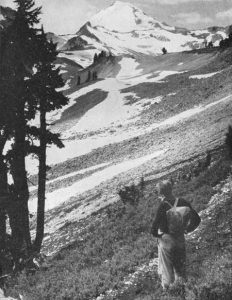RECREATION IS A FOREST PRODUCT
 NATIONAL forests were established (1) for the protection of watersheds and (2) for the sustained production and use of forests and forest products beneficial to mankind.
NATIONAL forests were established (1) for the protection of watersheds and (2) for the sustained production and use of forests and forest products beneficial to mankind.
Primary purposes of the management of the national forests are briefly: (1) To secure the maintenance of an adequate growth of trees and other vegetation on watersheds in order to aid in preventing floods, maintaining water levels and regularity of stream flow, preventing erosion, preserving water-power resources, preserving the purity of streams supplying water for domestic use  in towns and cities; (2) to provide protection against forest fires, insects, disease, and other destructive agents; (3) to contribute toward maintenance of a permanent timber supply to meet the needs of dependent communities, regions, and the whole country; (4) to serve as demonstration areas of both large and small scale forest management for private timber owners and operators, including farmers; (5) to secure a sustained supply of forage on forest lands for the grazing of game and domestic livestock; (6) to preserve the beauty and attractiveness of the forests for the recreation and pleasure of the people; and (7) to assist in the broad social program of building a more stable and prosperous Nation.
in towns and cities; (2) to provide protection against forest fires, insects, disease, and other destructive agents; (3) to contribute toward maintenance of a permanent timber supply to meet the needs of dependent communities, regions, and the whole country; (4) to serve as demonstration areas of both large and small scale forest management for private timber owners and operators, including farmers; (5) to secure a sustained supply of forage on forest lands for the grazing of game and domestic livestock; (6) to preserve the beauty and attractiveness of the forests for the recreation and pleasure of the people; and (7) to assist in the broad social program of building a more stable and prosperous Nation.

Towering snow-clad peaks beckon the hiker—Mount Baker National Forest,Wash. (F—385262)
Public recreation and inspiration are definitely recognized and treated as forest products, taking their proper place in development and management plans.
The distinctive characteristic of national forests is that they are properties managed for the sustained production of a variety of products which, in one way or another, may be harvested. For instance, ripe timber is sold for cutting under practices which insure sustained production; domestic livestock are permitted to graze up to the permanent forage-producing capacity of the land; water is used in many ways—irrigation, power, domestic supplies, industrial uses, recreation, etc.; game and fish are taken under suitable limitations; and recreation is enjoyed in many forms by millions of people.
All these uses of the national-forest system are handled under a coordinated plan of management known as multiple use. This means that most of the national-forest areas yield not one but several different crops and services at the same time. Thus timber harvesting, stock grazing, various uses of water, hunting and fishing, berry picking, and similar activities may go along together by so adjusting each that it does not measurably interfere with the others. Here and there, of course, some one use may be so important as to give it the right-of-way to the exclusion of the others, and the multiple-use plan provides for this. The controlling objective is to maintain a coordinated pattern of use which will produce the largest net total of public benefits.

